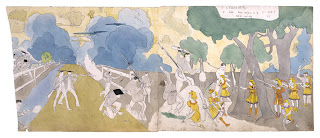
Henry Darger was born April 12(?), 1892 in Chicago. At the death of Henry’s father in 1905, Darger was institutionalized with the diagnosis that “little Henry’s heart is not in the right place.” A series of escapes ended successfully in 1908. Eventually, Darger found menial employment as a janitor in a Catholic hospital where he remained until his retirement. Darger lived a solitary, reclusive life whose patterns seemed to vary little; he attended Catholic mass every day up to 5 times a day and collected a baffling array of trash from the streets. Darger settled into his 2nd floor apartment in the Lincoln Park area of Chicago where his novel The Story of the Vivian Girls, in What is Known as the Realms of the Unreal, of the Glandeco-Angelinnian War Storm, Caused by the Child Slave Rebellion, and accompanying images were conceived and produced.
His novel consists of 15, densely-typed volumes of 15,145 total pages. “The text is accompanied by three bound volumes of several hundred illustrations, scroll-like watercolor paintings on paper, the work of six decades, derived from magazines and coloring books.” His figures were derived from these, having either been collaged together or traced. Some of his favorite figures were the Coppertone Girl and Little Annie Rooney. His work encompasses themes such as good versus evil, in which the Vivian Girls are seen as martyrs. The epic scale of his collages is suitable to the length of his novel and seems only appropriate so that they may portray the immense detail of his words. Here is a quick synopsis of his book:
In the Realms of the Unreal postulates a large planet around which Earth orbits as a moon and where most people are Christian (mostly Catholic). The majority of the story concerns the adventures of the daughters of Robert Vivian, seven sisters who are princesses of the Christian nation of Abbieannia and who assist a daring rebellion against the evil John Manley's regime of child slavery imposed by the Glandelinians. Children take up arms in their own defense and are often slain in battle or viciously tortured by the Glandelinian overlords. The elaborate mythology also includes a species called the "Blengigomeneans" (or Blengins for short), gigantic winged beings with curved horns who occasionally take human or part-human form, even disguising themselves as children. They are usually (but not always) benevolent; some Blengins are extremely suspicious of all humans, due to Glandelinian atrocities.
In The Realms of the Unreal, the "assassination of the child labor rebel Annie Aronburg... was the most shocking child murder ever caused by the Glandelinian Government," and was the cause of the war. Through their sufferings, valiant deeds and exemplary holiness, the Vivian Girls are hoped to be able to help bring about a triumph of Christianity. Darger provided two endings to the story: In one, the Vivian Girls and Christianity are triumphant; in the other, they are defeated and the godless Glandelinians reign.






























